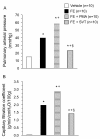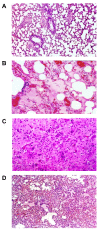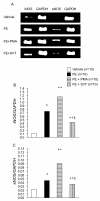Effects of phorbol myristate acetate and sivelestat on the lung injury caused by fat embolism in isolated lungs
- PMID: 22216930
- PMCID: PMC3265425
- DOI: 10.1186/1423-0127-19-3
Effects of phorbol myristate acetate and sivelestat on the lung injury caused by fat embolism in isolated lungs
Abstract
Background: Fat embolism syndrome (FES) associated with acute lung injury (ALI) is a clinical condition following long bone fracture. We have reported 14 victims due to ALI with FES. Our laboratory has developed an animal model that produced fat emboli (FE). The major purpose of this study was to test whether neutrophil activation with phorbol myristate acetate (PMA) and inhibition with sivelestat (SVT) exert protection on the lung.
Methods: The lungs of Sprague-Dawley rats were isolated and perfused. FE was produced by addition of corn oil micelles into the lung perfusate. PMA and SVT were given simultaneously with FE. Parameters such as lung weight/body weight ratio, LW gain, exhaled nitric oxide (NO), protein concentration in bronchoalveolar lavage relating to ALI were measured. The neutrophil elastase (NE), myeloperoxidase, malondialdehyde and phopholipase A₂ activity were determined. We also measured the nitrate/nitrite, methyl guanidine (MG), and cytokines. Pulmonary arterial pressure and microvascular permeability were assessed. Lung pathology was examined and scored. The inducible and endothelial NO synthase (iNOS and eNOS) were detected.
Results: FE caused ALI and increased biochemical factors. The challenge also resulted in pulmonary hypertension and increased microvascular permeability. The NE appeared to be the first to reach its peak at 1 hr, followed by other factors. Coadministration with PMA exacerbated the FE-induced changes, while SVT attenuated the effects of FE.
Conclusions: The FE-induced lung changes were enhanced by PMA, while SVT had the opposite effect. Sivelestat, a neutrophil inhibitor may be a therapeutic choice for patients with acute respiratory distress syndrome (ARDS) following fat embolism.
Figures






Similar articles
-
N-acetylcysteine attenuates the acute lung injury caused by phorbol myristate acetate in isolated rat lungs.Pulm Pharmacol Ther. 2007;20(6):726-33. doi: 10.1016/j.pupt.2006.08.010. Epub 2006 Sep 19. Pulm Pharmacol Ther. 2007. PMID: 17071120
-
Niacinamide mitigated the acute lung injury induced by phorbol myristate acetate in isolated rat's lungs.J Biomed Sci. 2012 Mar 1;19(1):27. doi: 10.1186/1423-0127-19-27. J Biomed Sci. 2012. PMID: 22375599 Free PMC article.
-
N-acetylcysteine attenuates acute lung injury induced by fat embolism.Crit Care Med. 2008 Feb;36(2):565-71. doi: 10.1097/01.CCM.0000299737.24338.5C. Crit Care Med. 2008. PMID: 18216605
-
From neurogenic pulmonary edema to fat embolism syndrome: a brief review of experimental and clinical investigations of acute lung injury and acute respiratory distress syndrome.Chin J Physiol. 2009 Nov 30;52(5 Suppl):339-44. doi: 10.4077/cjp.2009.amh036. Chin J Physiol. 2009. PMID: 20359124 Review.
-
[Pharmacological profile of a specific neutrophil elastase inhibitor, Sivelestat sodium hydrate].Nihon Yakurigaku Zasshi. 2003 Aug;122(2):151-60. doi: 10.1254/fpj.122.151. Nihon Yakurigaku Zasshi. 2003. PMID: 12890901 Review. Japanese.
Cited by
-
VEGF mediates fat embolism-induced acute lung injury via VEGF receptor 2 and the MAPK cascade.Sci Rep. 2019 Aug 12;9(1):11713. doi: 10.1038/s41598-019-47276-4. Sci Rep. 2019. PMID: 31406128 Free PMC article.
References
-
- White T, Petrisor BA, Bhandari M. Prevention of fat embolism syndrome. Injury. 2006;37:S59–S67. - PubMed
-
- Liu DD, Hsieh NK, Chen HI. Histopathological and biochemical changes following fat embolism with administration of corn oil micelles: a new animal model for fat embolism syndrome. J Bone Joint Surg Br. 2008;90:1517–1521. - PubMed
Publication types
MeSH terms
Substances
LinkOut - more resources
Full Text Sources
Research Materials
Miscellaneous

